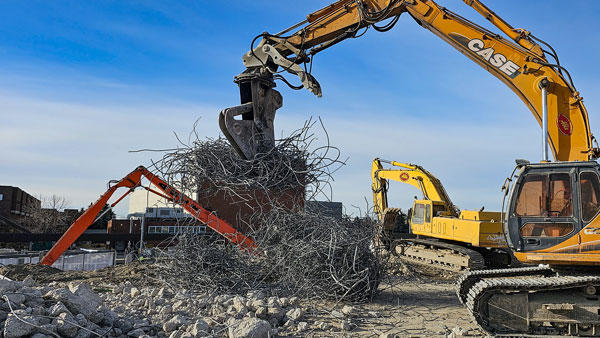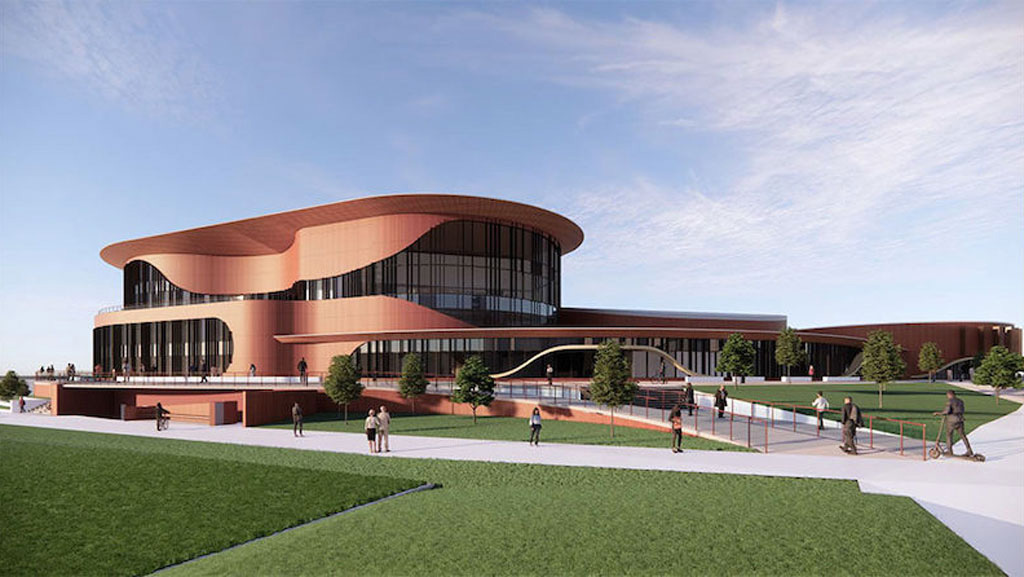Demolition at the Southern Alberta Institute of Technology (SAIT) Calgary campus where the last remnants of its end-of-life 30,000-square-metre conference centre are being removed is serving as an ultra-green project for recycling building components.
And, part of that recycled process is seeing the old steel roof beams reused in a river project that will create a new challenging wave for surfers and kayakers on an Alberta river. Some 20 tons of steel are being donated by Able Demolition Services Ltd. to be used in the construction of a multi-adjustable river wave system on the Kananaski River, downstream from the well-known Mountain Wave.
Mountain Wave was designed and built by Surf Anywhere for the Alberta River Surfing Association in 2014. Surf Anywhere’s newest addition, the multi-adjustable wave system, which can be used for both surfing and white water kayaking, is slated to begin construction in 2024 after going through a redesign in spring 2023.
“We are also donating our (beam) engineering and some equipment,” said Ed Meyer, Able president and owner, adding the donations will save tens of thousands of dollars in the proposed new construction.
Meyer said his company is known for reusing and recycling materials on demolition jobs so material is diverted from landfill.

Shooting for material diversion rates into the 90s is common, said Meyer, and that strong focus of reusing and recycling has meant that he often doesn’t get all the contracts he bids on. But, his list of clients include some of Canada’s largest builders and major institutions as priority builds to keep demolition waste out of landfill.
“We are not a company that just knocks it down, rolls it up and throws it away,” he said as the company has been onsite for 18 months at SAIT finding markets and places for demo waste.
It’s that kind of expertise that has meshed with SAIT’s decommissioning and demolition philosophy as the school wanted to promote sustainable development onsite.
“We had a very elaborate decommission and waste strategy,” said Tanya Tam, SAIT senior project manager for facilities development.
The 1982-built conference centre located mid-campus served mainly as an athletics and recreation facility with a pool, arena and gymnasium as well as some meeting space.
SAIT is looking to reach a demolition construction waste diversion rate of 95 per cent (by weight) when demolition is complete with only a small portion ending up in landfill.
“We are currently at 85 per cent,” said Tam, as the building’s concrete foundations are coming out of the ground for recycling.
Demolition will be finished by December of this year, with some site prep occurring over the winter and construction on the new conference and sports complex starting in spring. Bird Construction has been awarded the progressive design-build contract.
Tam said during the decommissioning and demolition process there has been a concerted focus on reuse and repurposing materials. After staff and users were relocated and any usable materials from the old building reused in other campus structures, there was an assessment of the remaining salvageable and usable items that could go to charities or organizations that dealt in recycled goods.
“It was the kind investment that took eight to 12 months,” Tam said, as it required finding users and keeping tabs on the tonnage of donated goods.
“We donated up to 150 tons of what would have been corporate waste,” she said, with this including furniture, appliances, equipment and other salvage material.
Once these items had been removed, the asbestos abatement team moved in and the demolition of the structure, the next phase, started. But, again the focus was on reuse and recycle.
As well as the beams, other structural components have also been reused and a separations area was established near the building for sorting materials. The exterior and interior building bricks went to a recycling facility to be prepped for reuse.
Yard waste, mainly wood, was chipped and recycled into other wood products. Metals are being sort and sent to smelters for recycling. Meyer said the concrete foundations that are now being demolished will be torn apart to retrieve steel rebar and the concrete material crushed for reuse.
The new facility, which is still being designed by GEC Architecture, will have many of the same facilities as the old structure but the pool has been eliminated. Tam said the campus is hoping to attain a LEED Gold designation for the new structure.
“It will have a slightly smaller footprint and be much more energy efficient,” she said.
There is no cost figure available for the new structure as design is ongoing. The structure is to be complete in 2027.





Recent Comments
comments for this post are closed